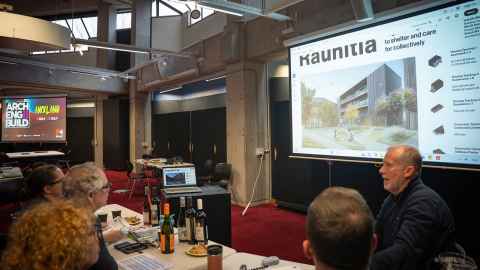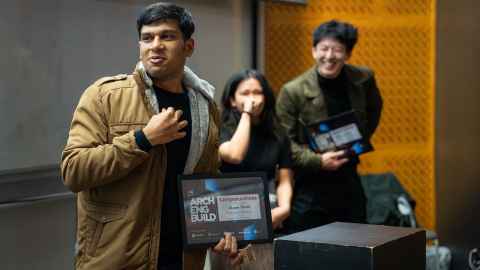Community at heart of students' winning housing design
10 July 2025
A team of architecture and engineering students have just won a 72-hour design competition with a flood-resistant housing scheme focused on community.

The idea that strong communities are better able to cope with natural disasters inspired a team of students that have just won a national 72-hour design competition.
This year's ArchEngBuild Challenge brought together 40 of Aotearoa New Zealand's top architecture, engineering and construction students from multiple universities.
The brief was to come up with a design for sustainable housing that could withstand natural disasters, be affordable and easily reinstated. The site was at the bottom of Auckland Domain, a site hit hard in the 2023 Auckland Anniversary Weekend floods.
The winning design, Rauhītia, featured timber buildings on stilts, water ponds, and communal facilities to bring people together.
"Our design was born from the idea that resilience isn't just about surviving disaster, it's about building communities that are connected, adaptable and empowered," says Enoch Shi, an architecture student from Waipapa Taumata Rau, University of Auckland and member of the winning team.
"We wanted to create a housing model that could serve day-to-day life just as well as it could respond to emergencies. The final concept balances disaster-resilient infrastructure with strong community spaces that foster social connection."

The winning team comprises Shi, Shivam Bansal, studying structural engineering at the University of Auckland, Isabella Mercado, a sustainable engineering student from Te Herenga Waka, Victoria University of Wellington, and construction management student Beatrice Hong from Otago Polytechnic. The group received a $12,000 prize, split evenly among its members.
"We knew from the beginning that resilience had to be both structural and social. That became the heart of our concept," says Shi.
Rauhītia, which means "to gather, to shelter and care for one another" in te reo Māori, embodies this spirit.
With flooding and earthquakes identified as the two main risks, the team used the land's natural topography to safely manage water flow and incorporated design elements that could support both emergency response and long-term recovery.

For Bansal, the experience was a rewarding and eye-opening opportunity to respond to real-word issues facing the built environment sector.
"I had so much fun working with the best team. It was like a dream. Designing everything from scratch and completing it in just 72 hours was challenging, but I learned a lot about how much effort goes into making a building stand," he says.
Dr Ferdinand Oswald, a senior lecturer in Architecture and Planning and a judge for this year's ArchEngBuild Challenge, said the main theme was resilience.
"It was about building for hazards, but the winning team understood that it is about community at its heart."
Media contact
Jogai Bhatt | Media adviser
M: 027 285 9464
E: jogai.bhatt@auckland.ac.nz